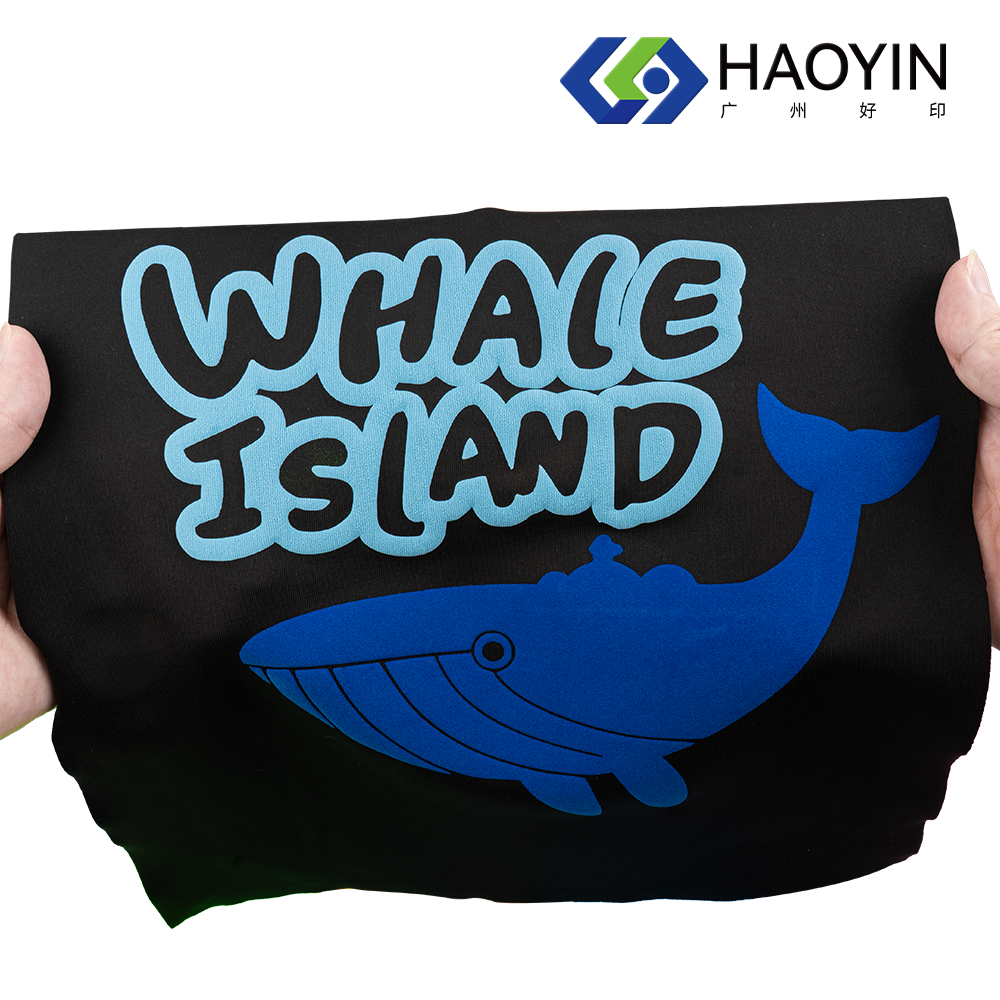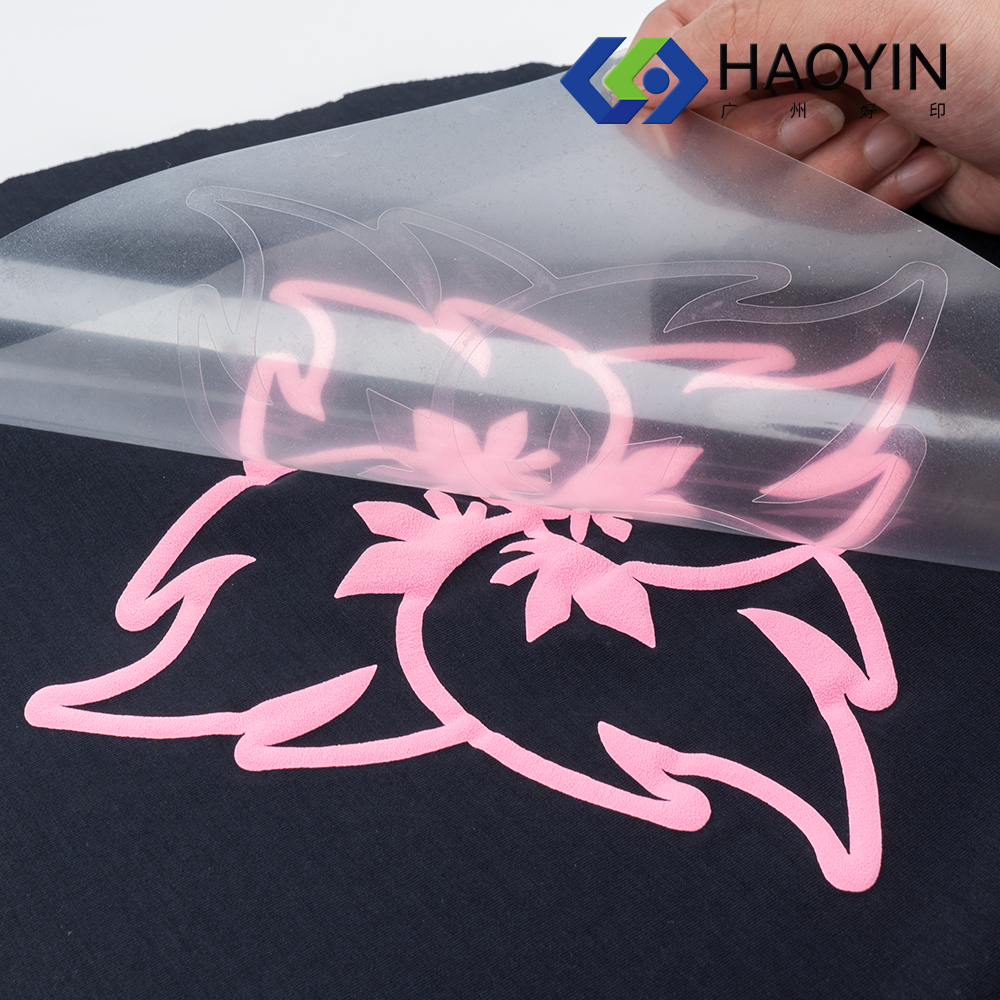تفاوت بین HTV سهبعدی ضخیم و HTV پفی
وینیل انتقال حرارت (HTV) به یکی از مواد بسیار کاربردی در سفارشیسازی لباس، لوازم جانبی و حتی دکوراسیون داخلی تبدیل شده است. این ماده در بسیاری از انواع پرایدها و بافتها موجود است و هر کدام به محصول نهایی سبکی منحصربهفرد میدهند. دو گزینه که اغلب موجب کنجکاوی میشوند، HTV ضخیم سهبعدی و پف اچتیوی .
به نظر اولیه ممکن است شبیه به هم باشند، چرا که هر دو ایجاد یک اثر برجسته و سهبعدی میکنند. با این حال، روش تولید آنها، واکنش آنها به گرما و احساسی که روی پارچه ایجاد میکنند، کاملاً متفاوت است. اگر میخواهید طرحهای شما با عمق و بافت برجسته شوند، درک تفاوت بین این دو نوع به شما کمک میکند تا وینیل مناسبی را برای پروژهتان انتخاب کنید.
HTV ضخیم سهبعدی چیست؟
hTV ضخیم سهبعدی نوعی وینیل انتقال حرارتی است که ارتفاع ظاهری خود را از طریق ضخامت فیزیکی به جای انبساط شیمیایی به دست میآورد. این ماده از چندین لایه متراکم وینیلی ساخته میشود و حتی قبل از پرس، نسبت به HTV استاندارد ارتفاع قابل ملاحظهای دارد.
هنگامی که گرما و فشار اعمال میشود، ماده به پارچه میچسبد اما ضخامت آن به طور قابل توجهی تغییر نمیکند. این بدان معناست که ظاهری که قبل از پرس دیده میشود، تقریباً دقیقاً همان چیزی است که پس از پرس به دست میآید. ظاهر برجسته شده یکنواخت، ساختارمند و مقاوم است و برای طرحهایی که نیاز به پایان کاری قوی و حرفهای دارند، ایدهآل است.
hTV سهبعدی ضخیم اغلب سطحی صاف دارد که بسته به برندها میتواند از نوع مات تا ساتن باشد. این ماده برای طرحهایی که لبههای تیز و خطوط تمیز اهمیت دارند، مانند حروف ورزشی، لوگوهای برجسته یا برندینگ حرفهای، عملکرد خوبی دارد.
HTV پفی چیست؟
پف اچتیوی , از سوی دیگر، یک فویل انتقال حرارت است که با اعمال حرارت به طور قابل توجهی تغییر میکند. این فویل دارای یک عامل متورمکنندهٔ حرارتی خاص در لایههایش است. هنگامی که حرارت اعمال میشود، این عامل منبسط میشود و باعث میشود فویل باد کند و سطحی نرم و شبیه به فوم ایجاد کند.
این انبساط باعث میشود HTV Puff بافتی گرد و مانند بالشتک داشته باشد که لمسی سبک و هوایی دارد. لبههای طرح تمایل به نرمی پیدا میکنند، چرا که ماده منبسط میشود، در نتیجه ظاهری غیررسمی یا قدیمیتر نسبت به لبههای دقیق HTV ضخیم سهبعدی ایجاد میشود.
HTV Puff برای طرحهای شاد، بازیگوشانه و سبک قدیمی محبوب است، همچنین برای پروژههایی که بافت لمسی عنصر کلیدی طراحی است. این ماده به ویژه روی هودیها، پیراهنهای پنبهای و لباسهای خیابانی جلب توجه میکند.
تفاوت در ترکیب مواد
یکی از مهمترین تفاوتهای بین HTV ضخیم سهبعدی و HTV Puff نحوهٔ دستیابی به ارتفاع آنهاست.
hTV ضخیم سهبعدی به دلیل ساختار مواد جامد خود به ضخامت در حین تولید وینیل ایجاد میشود، بنابراین اثر نهایی بلند شده از قبل تعیین میشود و نیازی به اعمال گرما نیست. این امر منجر به ارتفاع محکم و یکنواختی میشود که در طول زمان تغییر نمیکند مگر اینکه آسیب ببیند.
HTV پفی، با این حال، ابعاد خود را از انبساط شیمیایی در حین فرآیند پرس گرمایی به دست میآورد. این بدان معناست که ارتفاع نهایی آن به شرایط پرس مانند دما، فشار و زمان پرس وابسته است. اثر پفی برای هر بار پرس متفاوت است و هر قطعه ظاهری کمی متفاوت به خود میگیرد.
تفاوتهای فرآیند اعمال
اگرچه هر دو نوع وینیل برای اعمال نیازمند یک پرس گرم یا ابزار مشابه هستند، فرآیند این کار در برخی موارد کلیدی متفاوت است.
hTV ضخیم سهبعدی بهصورت تقریباً مشابه با HTV معمولی اعمال میشود. شما باید دمای توصیلی توسط سازنده، فشار و زمان پرس را دنبال کنید و ماده روی پارچه بدون تغییر زیاد در شکل، میچسبد. این موضوع باعث میشود نتیجه نهایی قابلپیشبینیتر باشد و بتوان همان ظاهر را روی چندین آیتم تکرار کرد.
HTV پفی نیازمند کنترل دقیقتری در هنگام اعمال است. اگر فشار کم باشد، ممکن است بهخوبی منبسط نشود و باعث شود بافت آن مسطح یا نامنظم باقی بماند. اگر فشار زیاد باشد یا دمای بیشازحد باشد، اثر پفی میشکند و کمتر دیده میشود. به همین دلیل، قبل از شروع یک کار بزرگ، انجام تستهایی از قبل ضروری است.

ظاهر و احساس دادهشده پس از پرس کردن
پس از پرس کردن، HTV ضخیم سهبعدی احساسی محکم و ساختاریافته دارد. این ماده سنگینتر است و به لباسها حضوری برجستهتر، شبیه به دوخت کار میدهد. لبههای طرح تیز هستند که برای متون، اعداد یا اشکال هندسی بسیار مناسب است.
پف HTV احساس نرمتری را در زیر انگشتان شما ایجاد میکند. بافت آن شبیه به بالشتک است و کمتر سفت است و ظاهری غیررسمیتر ایجاد میکند. لبهها با گسترش ماده کمی گرد میشوند و طرحها را دارای خطوط نرمتری میکند. این ویژگی آن را برای طرحهای شاد، اشکال ارگانیک و حروف به سبک قدیمی مناسب میکند.
دوام در طول زمان
hTV ضخیم 3D عموماً در برابر سایش و فرسودگی مقاومتر است. به دلیل اینکه جامد و متراکم است، میتواند در برابر شستوشهای مکرر بدون از دست دادن زیاد ارتفاع مقاومت کند. با رعایت مراقبتهای لازم — مانند شستن کار برگرداندن لباس و اجتناب از خشککردن در دمای بسیار بالا — میتواند به مدت طولانی تقریباً جدید به نظر برسد.
HTV پف دار دوام خوبی دارد، اما چون ارتفاع آن از ساختاری هواپردا و منبسطشده به دست میآید، ممکن است به تدریج با شستوش و پوشیدن مکرر، فشرده شود. اثر پف هم نسبت به گرمای زیاد پس از اتوکاری بیشتر حساس است، بنابراین باید دستورالعملهای مراقبتی را به دقت دنبال کرد.
وزن و انعطافپذیری
ماهیت متراکم HTV ضخیم سهبعدی باعث میشود که این ماده سنگینتر و کمتر انعطافپذیر از HTV پفی باشد. این میتواند یک مزیت برای طرحهایی باشد که به دنبال احساسی لوکس و ساختاریافته هستند، اما ممکن است در لباسهای سبک احساس سفتی ایجاد کند.
HTV پفی بسیار سبک و انعطافپذیر است. این ماده به راحتی با پارچه حرکت میکند و حتی روی لباسهای نازک نیز راحتی خوبی فراهم میکند. همین موضوع باعث محبوبیت آن در لباسهای غیررسمی و ورزشی شده است.
کاربردهای بهینه HTV ضخیم سهبعدی
hTV سهبعدی ضخیم بیشتر برای طرحهایی که به یک پایان کار یکنواخت و حرفهای با تأثیر بصری قوی نیاز دارند، مناسب است. کاربردهای مناسب شامل موارد زیر میشود:
پیراهنهای ورزشی با شمارهها و نامهای برجسته.
لگوهای شرکتی برای پوشیدنیهای کارمندی یا پوشاک تبلیغاتی.
طرحهای با کنتراست بالا روی کتها، هودیها و لباسهای بیرونی.
پوشاکی که باید ظاهر لوکس خود را در طول شستوشوی متعدد حفظ کنند.
کاربردهای بهینه HTV پفی
HTV پفی زمانی به خوبی عمل میکند که بخواهید به شخصیت و بافتی خاص به طرح خود اضافه کنید. این ماده برای موارد زیر بسیار مناسب است:
سبکهای پوشاک خیابانی و مد شهری
پوشاک کودکانه با الگوهای شاد یا شخصیتهای کارتونی
پیراهن و هودی با الهام از سبک رترو
پروژههای هنری که بافت بخشی از مفهوم طراحی است
نکاتی برای اعمال HTV ضخیم سهبعدی
همیشه تنظیمات پیشنهادی توسط سازنده را برای دما، زمان و فشار در نظر بگیرید.
از روی هم قرار دادن چند لایه HTV ضخیم خودداری کنید، چون میتواند باعث ایجاد ضخامت بیشازحد شود.
به گارمنت زمان دهید تا خنک شود و سپس لایهبرداری کنید تا از کشیده شدن طرح جلوگیری شود.
برای برشهای پیچیده، با دقت عمل کنید تا لبههای تیز حفظ شوند.
نکاتی برای اعمال HTV پفی
پارچه را قبل از کار اتو کنید تا رطوبت آن گرفته شود و چروکهای آن صاف شود.
فشار یکنواخت و متوسط اعمال کنید تا از له شدن اثر پفی جلوگیری شود.
پس از اولین اعمال HTV پفی را دوباره اتو نکنید؛ گرمای مجدد میتواند باعث فرو افتادن اثر پفی شود.
قبل از شروع به کار، ابتدا روی یک تکه پارچه آزمایشی یا نمونه پارچه تست کنید.
نگهداری و مراقبت
مراقبت صحیح از هر نوع، باعث افزایش عمر مفید آن خواهد شد.
برای HTV ضخیم سهبعدی: پارچهها را از روی درآورده و با آب سرد یا گرم بشویید و از خشککردن با گرمای زیاد خودداری کنید. این ماده مقاوم است، اما گرما بیش از حد در طول زمان میتواند چسبندگی آن را کاهش دهد.
برای HTV پفی: شستوشوی ملایم بسیار مهم است، همچنین از اعمال گرمای بیش از حد در هنگام خشک کردن خودداری کنید. خشک کردن در هوای آزاد یا با استفاده از دمای پایین در ماشین لباسشویی میتواند به حفظ اثر پفی کمک کند. از اتو کردن مستقیم روی طرح طراحی اجتناب کنید.
ترکیب هر دو در یک طرح
برخی از طراحان ترکیب HTV ضخیم سهبعدی و HTV پفی را در یک پروژه برای ایجاد کنتراست خلاقانه دوست دارند. به عنوان مثال، میتوانید از HTV ضخیم سهبعدی برای لبههای برجسته و از HTV پفی برای پر کردن داخل استفاده کنید تا اثری لایهلایه و لمسی ایجاد شود. این روش به خصوص برای قطعات برجسته و پروژههای برندینگ سفارشی بسیار مناسب است.
اشتباهات رایجی که باید از آنها اجتناب کنید
استفاده از دمای زیاد یا زمان بیش از حد در فشار دادن HTV پفی که میتواند باعث مسطح شدن آن شود.
لایهگذاری HTV پفی زیر دیگر وینیلها، که از انبساط مناسب آن جلوگیری میکند.
همپوشانی بیش از حد وینیلهای ضخیم در یک ناحیه، که میتواند باعث ناراحتی در لباس شود.
فوت کردن تست فشار، به خصوص با HTV پفی، چون انبساط میتواند متفاوت باشد.
سوالات متداول
چه چیز HTV پفی را از دیگر وینیلها متفاوت میکند؟
HTV پفی دارای یک عامل فومکننده خاص است که در حین فشار گرمایی منبسط میشود و باعث ایجاد بافتی نرم و برجسته میشود که برخلاف ظاهر جامد و ساختاریافته دیگر HTVهاست.
آیا HTV پفی را میتوان روی تمام پارچهها استفاده کرد؟
پف اچتیوی روی اکثر پارچههایی که میتوانند حرارت استاندارد اچتیوی را تحمل کنند کار میکند، اما ممکن است برخی پارچههای ظریف نیاز به دمای پایینتر و زمان پرس کوتاهتری داشته باشند.
آیا اچتیوی ضخیم سهبعدی از پف اچتیوی مقاومتر است؟
بله، در بیشتر موارد. ساختار جامد اچتیوی ضخیم سهبعدی باعث میشود ارتفاع آن برای مدت طولانیتری حفظ شود، در حالی که ساختار هوایی پف اچتیوی ممکن است به تدریج با استفاده مسطح شود.
آیا میتوانم پف اچتیوی را لایهای کنم؟
پیشنهاد نمیشود که پف اچتیوی را زیر سایر مواد لایهای کنید، زیرا فرآیند انبساط ممکن است محدود شود و منجر به نتایج ناهموار گردد.
برای لباس ورزشی کدام گزینه بهتر است؟
اچتیوی ضخیم سهبعدی به طور کلی برای لباس ورزشی بهتر است، زیرا دوام بیشتری دارد و میتواند شستوشهای مکرر را بدون از دست دادن شکل خود تحمل کند.
فهرست مطالب
- تفاوت بین HTV سهبعدی ضخیم و HTV پفی
- HTV ضخیم سهبعدی چیست؟
- HTV پفی چیست؟
- تفاوت در ترکیب مواد
- تفاوتهای فرآیند اعمال
- ظاهر و احساس دادهشده پس از پرس کردن
- دوام در طول زمان
- وزن و انعطافپذیری
- کاربردهای بهینه HTV ضخیم سهبعدی
- کاربردهای بهینه HTV پفی
- نکاتی برای اعمال HTV ضخیم سهبعدی
- نکاتی برای اعمال HTV پفی
- نگهداری و مراقبت
- ترکیب هر دو در یک طرح
- اشتباهات رایجی که باید از آنها اجتناب کنید
- سوالات متداول



